#liberal feminism encouraging ‚sex work‘ as a cult
Text
we need more feminist horror
#there is so much potential there#rambling#the beauty industry… anti ageing… dieting….#female gender roles as a demon haunting you…#the prison of femininity…#menstruation pregnancy abortion as body horror#subversing horror tropes of female exploitation and male violence…#men as monsters… the patriarchy as a haunted house… competition between women as curse…#or just female slashers and serial killers who are not sexy for the female gaze#liberal feminism encouraging ‚sex work‘ as a cult#as some sort of commentary#WITCHES… the last girl becoming ‚evil‘ but what really is evil…#intergenerational female trauma…#male religion > occult horror#zombie as symbolism of trauma…#MOTHER DAUGHTER RELATIONSHIPS
88 notes
·
View notes
Text
Woke liberals and the occult

You may have noticed recently a proliferation of identity-centric liberals who also embrace magic and mysticism. They often, for example, argue (completely ahistorically) that belief in astrology is an inherently feminine practice, and so mocking someone for believing in fairies or wood nymphs or whatever is a sign of toxic masculinity. Where, you might wonder, does this come from?
I've been wanting to write something about this for a long time, but it would take a lot of work, and attaching my real name to any such piece would make me unemployable. Here's some raw notes:
Legitimizing the occult allows authoritarian feminists to exert power over the people they dislike, and to do so in a way that nominally exempts them from the problematics of engaging in straight-up carceral feminism or other regressive politics. And I don’t mean this in a metaphoric or loose sense. There’s real-life precedence of authoritarian feminists doing exactly this.
Satan's Silence (1995), a book by Debbie Nathan and Michael Snedeker, does an excellent job of detailing many prominent iterations of the 1980's "Satanic" sex panic. Their work displays some concerning parallels between the 80′s panic the current sex panic gripping the mainstream left.
Nathan and Snedeker unflinchingly connect the 80's-era satanic sex panic (SSP) to an alliance between authoritarian feminists and weirdo conservatives who worked in psychology and sociology. Pointedly, these tendencies were not native to earlier generations of feminism, but came about when creeps from other fields made a politically opportune pivot. One of the key architects of early SSP was Dr. Roland Summit, a Freudian psychiatrist who was the head physician at LA County’s child protection services in the 70’s. Early in his career, Summit was renowned for being sympathetic toward incestuous fathers, whom he believed were driven to rape their children due to the inadequacy of their wives.
This sounds unbelievable, I know. But bear in mind, up until pretty recently, sex crimes were conceptually medicalized, understood as mental disorders rather than as pure violence. “Rape is about power, not sex” may be the first principle for all contemporary analysis of sexual assault, but back then, experts were more keen on understanding these acts as stemming from purely sexual perversions. (This might make the outrageousness of that Abducted in Plain Sight documentary a bit more explicable). Dr. Summit didn’t exonerate incestuous fathers, but he did view parent-child attraction as a fixable disorder that stemmed from the breakdown of the traditional family structure. His beliefs were echoed by many prominent child abuse prevention programs, which tended to have “a strong bias toward preserving marriages” (22): the belief being that strong, two-parent families would result in a sort of psychological equanimity that would blot out any inclinations toward sexual abuse.
Of course, this is the opposite of first and second-wave feminist thought, which almost universally regarded traditional families as incubators of violence. However, prominent anti-violence feminists of the early 80’s “were willing to excuse these gaffes for various reasons. For one, they knew they could not get the government to support antidomestic violence efforts if they talked about skewered power, whether it derived from maldistribution of wealth or, even more unmentionably, from patriarchal inequality” (22). The psychology-dominated violence prevention agencies may have been patriarchal, but they had ample funding, and tremendous amounts of social clout. Most importantly, they had raw power: they could take away a family’s kids, and they could put men in jail.
If I was writing a longer piece, I’d include a caveat here that of course we shouldn’t conflate regular feminists with authoritarian feminists and point out the obvious conflicts going on here. But let’s just look at one of the authoritarians real quick: Judith Herman. Herman was one of the loudest and least repentant of the Satanic Panic/Repressed Memory therapy grifters, and she became involved with Summit’s institute in the late 70’s. She was drawn to the pro-family rehab programs because of their ability to retool male behavior and make men regard all of their sexual impulses as sources of shame. She even approvingly compared these men’s therapy sessions with “forced political reeducation programs in revolutionary societies” (23). (If you’re at all familiar with wokeism in the late twenty-teens, you already know how much shaming and reconditioning are considered the means and ends of feminist praxis.)
The authoritarian feminist/pro-family psychology alliance was based on a simple proposition: abusive men could submit to re-education therapy, or they could go to prison for a very long time. The former option was of course the one most chosen, and suddenly a carceral program based on regressive notions of sexuality and domesticity was given a woke gloss. This set the stage for the full-bore panic, and segues neatly to another tenet of our contemporary sex panic: the supposed moral imperative to believe every account proffered by every victim, no matter how implausible or impossible their stories may be. (Unless, it turns out, the accused is a prominent neoliberal Democrat).
Summit believed that, in his own words, “children never fabricate the kinds of explicit sexual manipulations they divulge in complaints or interrogations.” This meant not only that kids should be believed if they, for example, say their mom and dad murdered 20 babies in front of them, but that it was okay to foster a therapeutic environment in which caseworkers asked leading questions to coerce these kinds of stories out of kids. A father could find himself in counseling for something heavy (beating his wife) or minor (drinking too much and yelling), his kid could run into a caseworker who got them to describe profane abuse, and then the dad had a choice: he could admit to every allegation and enter into reeducation, or he could face multiple felony charges. This led, naturally, to an explosion of such cases. And the hucksters who had installed this system had created a feedback loop that validated their practices.
Demonology and other superstitions could easily infiltrate this milieu. Behavior modification programs have always been cult-like. Entering into them requires patients and practitioners to suspend all forms of critical thought that may undermine the group’s practices and presumptions. Once an empowered group loses all recourse to rationality and critical thought, it becomes quickly indecent. Absurd assumptions snowball. What were once understood as misplaced libidinal drives become overtaken by ghosts and devils. Family violence and personal unhappiness are caused not by social structures or simple interpersonal conflict, but by the presence of mystical evil. And it all makes sense to the people who are caught up in it: what good is empiricism, after all, when we are battling demons?
I could say a lot more here, but I encourage you look up the figures I've mentioned in this piece. To this day, Debbie Nathan is a pariah in most feminist spaces, while Judith Herman is a celebrated mental health professional who has received multiple awards from prestigious organizations. The latter's work led to dozens of people going to prison and thousands of children being badly traumatized, while the former did nothing more malignant than document professional abuse. When neurotic but marginalized people formulate a way to glom on the violence of powerful organizations, they are heavily rewarded. Other vicious idiots rush in and seize the opportunity to harm the people they hate. Sometimes their anger is righteous, sometimes it's entirely misplaced, but that's all beside the point. The point is power. Occult bullshit is an easy way for violent people to hurt others.
133 notes
·
View notes
Text
Feminism and its waves
1st Wave
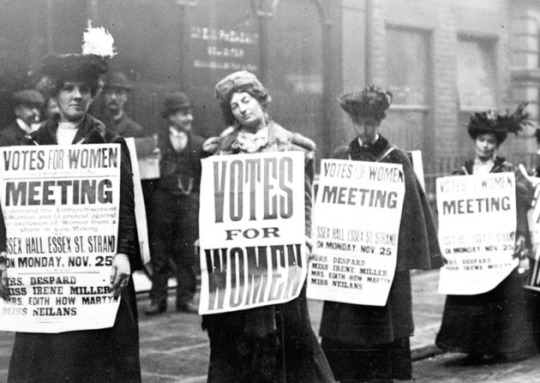
The first wave of feminism took place in the late nineteenth and early twentieth centuries, emerging out of an environment of urban industrialism and liberal, socialist politics. The goal of this wave was to open up opportunities for women, with a focus on suffrage. The wave formally began at the Seneca Falls Convention in 1848 when three hundred men and women rallied to the cause of equality for women. Elizabeth Cady Stanton (d.1902) drafted the Seneca Falls Declaration outlining the new movement's ideology and political strategies.
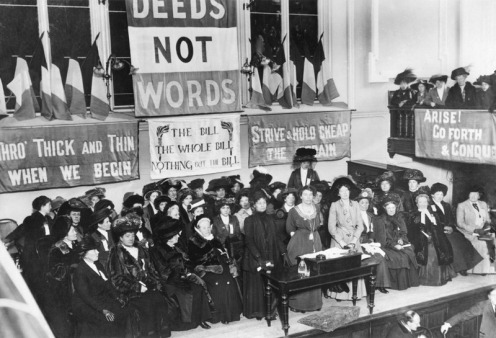
In its early stages, feminism was interrelated with the temperance and abolitionist movements and gave voice to now-famous activists like the African-American Sojourner Truth (d. 1883), who demanded: "Ain't I a woman?" Victorian America saw women acting in very "un-ladylike" ways (public speaking, demonstrating, stints in jail), which challenged the "cult of domesticity." Discussions about the vote and women's participation in politics led to an examination of the differences between men and women as they were then viewed. Some claimed that women were morally superior to men, and so their presence in the civic sphere would improve public behavior and the political process. (https://www.pacificu.edu/magazine/four-waves-feminism)
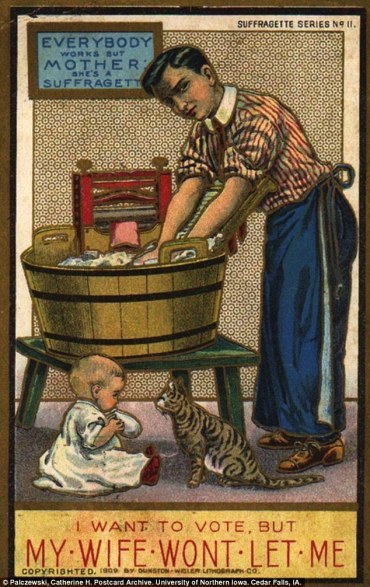
2nd Wave
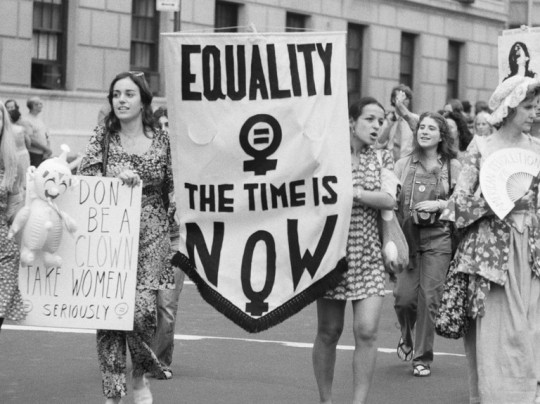
The second wave began in the 1960s and continued into the 90s. This wave unfolded in the context of the anti-war and civil rights movements and the growing self-consciousness of a variety of minority groups around the world. The New Left was on the rise, and the voice of the second wave was increasingly radical. In this phase, sexuality and reproductive rights were dominant issues, and much of the movement's energy was focused on passing the Equal Rights Amendment to the Constitution guaranteeing social equality regardless of sex.
This phase began with protests against the Miss America pageant in Atlantic City in 1968 and 1969. Feminists parodied what they held to be a degrading "cattle parade" that reduced women to objects of beauty dominated by a patriarchy that sought to keep them in the home or in dull, low-paying jobs. The radical New York group called the Redstockings staged a counter pageant in which they crowned a sheep as Miss America and threw "oppressive" feminine artifacts such as bras, girdles, high-heels, makeup and false eyelashes into the trashcan.
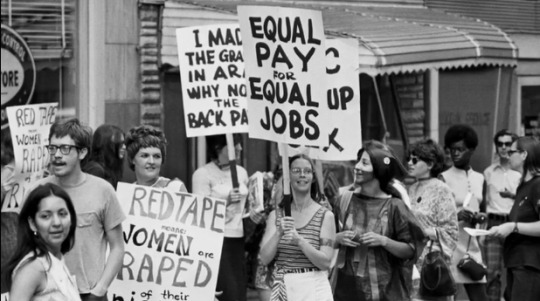
Because the second wave of feminism found voice amid so many other social movements, it was easily marginalized and viewed as less pressing than, for example, Black Power or efforts to end the war in Vietnam. Feminists reacted by forming women-only organizations (such as NOW) and "consciousness raising" groups. In publications like "The BITCH Manifesto" and "Sisterhood is Powerful," feminists advocated for their place in the sun. The second wave was increasingly theoretical, based on a fusion of neo-Marxism and psycho-analytical theory, and began to associate the subjugation of women with broader critiques of patriarchy, capitalism, normative heterosexuality, and the woman's role as wife and mother. Sex and gender were differentiated—the former being biological, and the later a social construct that varies culture-to-culture and over time.
Whereas the first wave of feminism was generally propelled by middle class, Western, cisgender, white women, the second phase drew in women of color and developing nations, seeking sisterhood and solidarity, claiming "Women's struggle is class struggle." Feminists spoke of women as a social class and coined phrases such as "the personal is political" and "identity politics" in an effort to demonstrate that race, class, and gender oppression are all related. They initiated a concentrated effort to rid society top-to-bottom of sexism, from children's cartoons to the highest levels of government.
One of the strains of this complex and diverse "wave" was the development of women-only spaces and the notion that women working together create a special dynamic that is not possible in mixed-groups, which would ultimately work for the betterment of the entire planet. Women, due whether to their long "subjugation" or to their biology, were thought by some to be more humane, collaborative, inclusive, peaceful, nurturing, democratic, and holistic in their approach to problem solving than men. The term eco-feminism was coined to capture the sense that because of their biological connection to earth and lunar cycles, women were natural advocates of environmentalism.(https://www.pacificu.edu/magazine/four-waves-feminism)
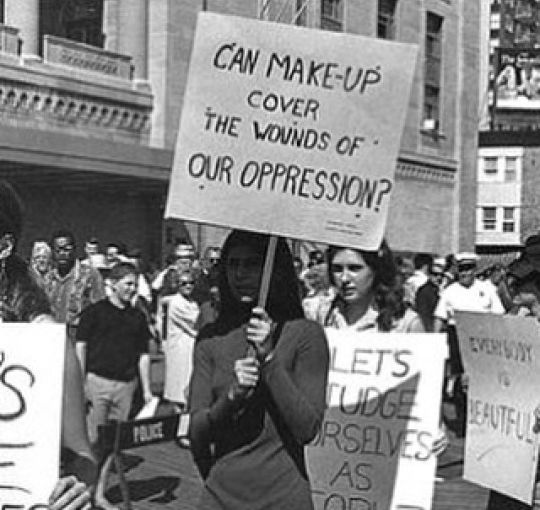
Critique to the 2nd wave: Some black and/or working class and poor women felt alienated by the main planks of the second-wave feminist movement, which largely advocated women's right to work outside the home and expansion of reproductive rights. Women of color and poor white women in the US had been working outside of the home in blue-collar and service jobs for generations. Additionally, Angela Davis wrote that while Afro-American women and white women were subjected to multiple unwilled pregnancies and had to clandestinely abort, Afro-American women were also suffering from compulsory sterilization programs that were not widely included in dialogue about reproductive justice.Beginning in the late 20th century, numerous feminist scholars such as Audre Lorde[118] and Winona LaDuke[119] critiqued the second wave in the United States as reducing feminist activity into a homogenized and whitewashed chronology of feminist history that ignores the voices and contributions of many women of color, working-class women, and LGBT women.[120][121]The second-wave feminist movement in the United States has been criticized for failing to acknowledge the struggles of women of color, and their voices were often silenced or ignored by white feminists.[122][120] It has been suggested that the dominant historical narratives of the feminist movement focuses on white, East Coast, and predominantly middle-class women and women's consciousness-raising groups, excluding the experiences and contributions of lesbians, women of color, and working-class and lower-class women.[43]Chela Sandoval called the dominant narratives of the women's liberation movement "hegemonic feminism" because it essentializes the feminist historiography to an exclusive population of women, which assumes that all women experience the same oppressions as the white, East Coast, and predominantly middle-class women.[123] This restricting view purportedly ignored the oppressions women face determined by their race, class, and sexuality, and gave rise to women-of-color feminisms that separated from the women's liberation movement, such as Black feminism, Africana womanism, and the Hijas de Cuauhtémoc that emerged at California State University, Long Beach, which was founded by Anna Nieto-Gómez, due to the Chicano Movement's sexism.[124][125][126]Kimberlé Crenshaw coined the term "intersectionality" in 1989 in response to the white, middle-class views that dominated second-wave feminism. Intersectionality describes the way systems of oppression (i.e. sexism, racism) have multiplicative, not additive, effects, on those who are multiply marginalized. It has become a core tenet of third-wave feminism.[127] (wikipedia)
Black Feminism

Black feminism holds that the experience of Black women gives rise to a particular understanding of their position in relation to sexism, class oppression, and racism.[1][2] The experience of being a Black woman, it maintains, cannot be grasped in terms of being Black or of being a woman but must be elucidated via intersectionality,[3] a term coined by legal scholar Kimberlé Crenshaw in 1989. Crenshaw argued that each concept—being Black and being female—should be considered independently while understanding that intersecting identities deepen and reinforce one anothe
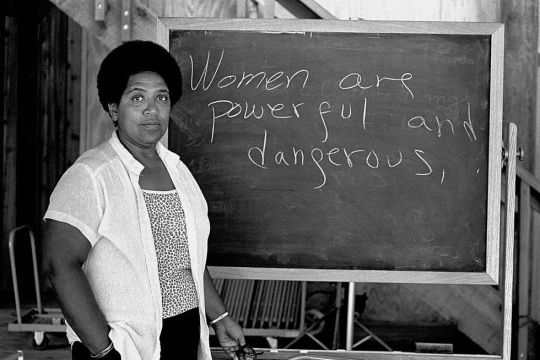
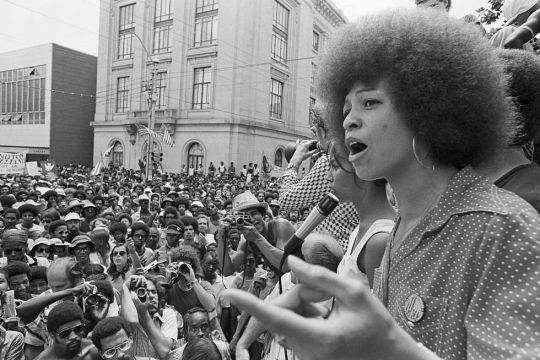
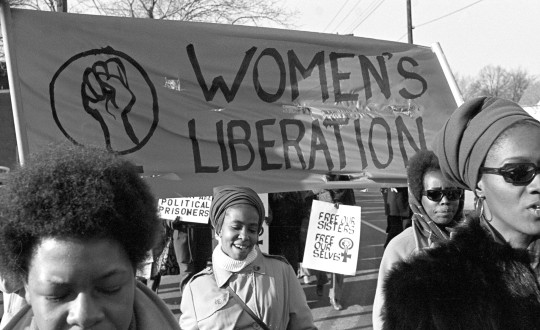
3rd WAVE
The third wave of feminism began in the mid-90's and was informed by post-colonial and post-modern thinking. In this phase many constructs were destabilized, including the notions of "universal womanhood," body, gender, sexuality and heteronormativity. An aspect of third wave feminism that mystified the mothers of the earlier feminist movement was the readoption by young feminists of the very lip-stick, high-heels, and cleavage proudly exposed by low cut necklines that the first two phases of the movement identified with male oppression. Pinkfloor expressed this new position when she said that it's possible to have a push-up bra and a brain at the same time.

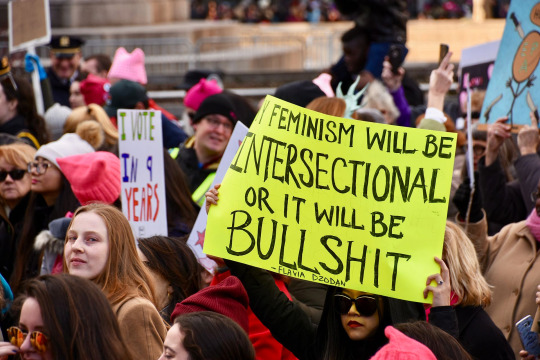
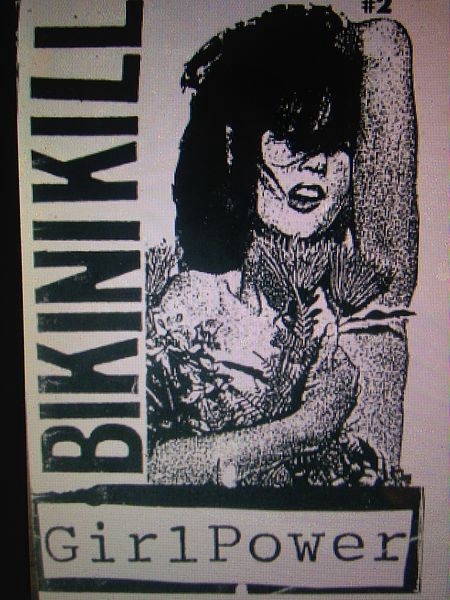
The "grrls" of the third wave stepped onto the stage as strong and empowered, eschewing victimization and defining feminine beauty for themselves as subjects, not as objects of a sexist patriarchy. They developed a rhetoric of mimicry, which appropriated derogatory terms like "slut" and "bitch" in order to subvert sexist culture and deprive it of verbal weapons. The web is an important tool of "girlie feminism." E-zines have provided "cybergrrls" and "netgrrls" another kind of women-only space. At the same time — rife with the irony of third-wave feminism because cyberspace is disembodied — it permits all users the opportunity to cross gender boundaries, and so the very notion of gender has been unbalanced in a way that encourages experimentation and creative thought.
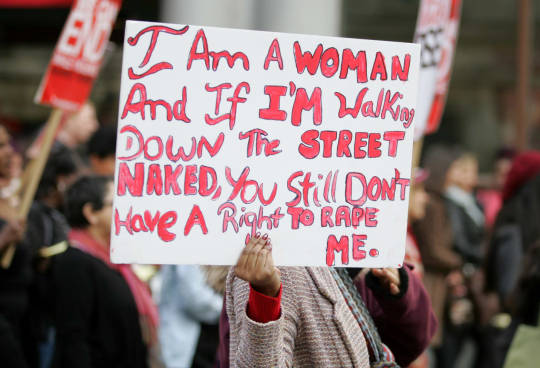
This is in keeping with the third wave's celebration of ambiguity and refusal to think in terms of "us-them." Most third-wavers refuse to identify as "feminists" and reject the word that they find limiting and exclusionary. Grrl-feminism tends to be global, multi-cultural, and it shuns simple answers or artificial categories of identity, gender, and sexuality. Its transversal politics means that differences such as those of ethnicity, class, sexual orientation, etc. are celebrated and recognized as dynamic, situational, and provisional. Reality is conceived not so much in terms of fixed structures and power relations, but in terms of performance within contingencies. Third wave feminism breaks boundaries.
(https://www.pacificu.edu/magazine/four-waves-feminism)
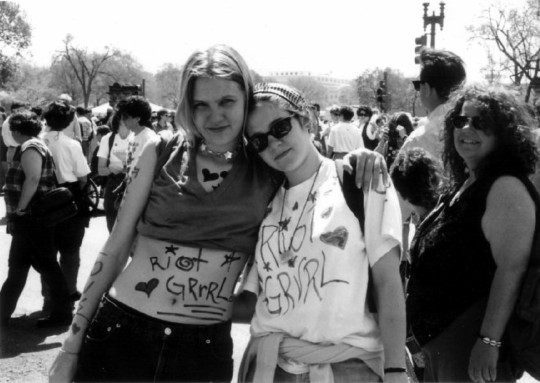

4th WAVE -

The Guardian-
Welcome to the fourth wave of feminism. This movement follows the first-wave campaign for votes for women, which reached its height 100 years ago, the second wave women's liberation movement that blazed through the 1970s and 80s, and the third wave declared by Rebecca Walker, Alice Walker's daughter, and others, in the early 1990s. That shift from second to third wave took many important forms, but often felt broadly generational, with women defining their work as distinct from their mothers'. What's happening now feels like something new again. It's defined by technology: tools that are allowing women to build a strong, popular, reactive movement online.
The majority of activists I speak to define themselves as intersectional feminists – or say they try to live up to this decription – and when I mention this to Kimberlé Crenshaw, the US law professor who coined the term intersectionality in 1989, she's genuinely surprised. The theory concerns the way multiple oppressions intersect, and although, as Crenshaw says, it can be interpreted in a wild variety of ways, today's feminists generally seem to see it as an attempt to elevate and make space for the voices and issues of those who are marginalised, and a framework for recognising how class, race, age, ability, sexuality, gender and other issues combine to affect women's experience of discrimination. Younis considers intersectionality the overriding principle for today's feminists, and Ali says she constantly tries to check her privilege, to recognise how hierarchies of power are constructed.
(https://www.theguardian.com/world/2013/dec/10/fourth-wave-feminism-rebel-women)
Britannica -
Although debated by some, many claim that a fourth wave of feminism began about 2012, with a focus on sexual harassment, body shaming, and rape culture, among other issues. A key component was the use of social media to highlight and address these concerns. The new wave arose amid a number of high-profile incidents. In December 2012 a young woman was brutally gang-raped in India and subsequently died, sparking local protests and international outrage. That was followed two years later by the Gamergate campaign, a manifestation of the so-called “men’s rights movement” that had its origins on the Web site 4chan. GamerGate ostensibly sought to promote ethics in video-game journalism, but it was in reality a harassment campaign against “social justice warriors.” The latter were often women who objected to female stereotypes in video games and were subsequently inundated with death threats and rape threats.
Against this background came Donald Trump’s defeat of Hillary Clinton in the U.S. presidential election in 2016. Trump had made a number of inflammatory remarks about women, and the day after the election a grandmother went on Facebook to propose a march on Washington, D.C. The suggestion quickly gained traction and became a call for social change, especially in regard to gender equality. Known as the Women’s March, it grew to include demonstrations across the United States and around the world. The protests took place on January 21, 2017, the day after Trump’s inauguration, and as many as 4.6 million people attended the various events in the United States, making the Women’s March perhaps the largest single-day demonstration in that country’s history.

Arguably even more significant was the Me Too movement, which was launched in 2006 in the United States to assist survivors of sexual violence, especially females of colour. The campaign gained widespread attention beginning in 2017, after it was revealed that film mogul Harvey Weinstein had for years sexually harassed and assaulted women in the industry with impunity. Victims of sexual harassment or assault around the world—and of all ethnicities—began sharing their experiences on social media, using the hashtag #MeToo. The movement grew over the coming months to bring condemnation to dozens of powerful men in politics, business, entertainment, and the news media.

10 notes
·
View notes
Text
'Indian feminist Vaishnavi Sundar has had screenings of her latest film pulled.'
"I am a filmmaker, writer and a women’s rights activist. I spend my time advocating for equal opportunities, contraceptive rights, education and the empowerment of women and girls. I centre women in all my work. When I started screening my film on workplace sexual harassment across India, I was hoping to raise public consciousness. But What Was She Wearing? was India’s first feature-length documentary on the subject.
I was cancelled for my tweets on transgenderism
Over the past few years, accounts of people being ‘cancelled’ appeared on my timeline. It was a phenomenon I had no proper understanding of, and the ramifications of it seemed exaggerated. Until it happened to me.
When I was first introduced to feminism, I followed the pervasive ‘choice’ model. It did not take me very long to find it antithetical to the women’s rights the Suffragettes fought for. It made oppression itself seem lucrative and enticing. It was when I began voicing my opinion on the perils of liberal feminism that cancel culture started making sense to me. I could see that women were being banned for speaking against patriarchy.
However, I encountered strong resistanceto the film from liberal feminist gatekeepers. Women who would send me private messages asking for professional favours and contacts, and congratulate me on the film, refused to acknowledge my presence on their public timelines or retweet anything about the film. At first, I thought this was my eternal bad luck or some flaw in my personality.
Then I began getting a series of rejections from liberal and left-leaning publications which had previously accepted every piece I sent in. One editor responded by saying she couldn’t accept my pieces as the publication was short-staffed. But she published three pieces from a male writer around the same time.
Last month, I discovered the reason I had become a social outcast in liberal-feminist bastions. I was in the US for an exchange programme, and I wanted to use the opportunity to screen my film at various places while I toured the country. One screening was scheduled in New York, organised by the Polis Project. The proverbial i’s were dotted, posters designed and I was even introduced to a female Indian moderator. But a week before the screening, the organiser (also a woman of Indian origin) sent me an email. She said the event would be cancelled because of my ‘transphobic’ views.
Many moons ago I got into a Twitterspat about pre-op trans women in women’s shelters, prisons, bathrooms and women’s sports. And someone had brought the tweets in question to the organisers’ attention. As a result, the Polis Project thought it was only fair to shelve a screening of a film about a pressing topic that affects women across all social strata in society. All because the filmmaker believes biological sex is not a social construct, that women’s sex-based oppression is real, that housing people with male genitalia in spaces with victims of male sexual violence can be harrowing to women inmates, that mental illnesses like autogynephilia and other dysphorias can cause dangerous, irrevocable damage, and that gender theorists are erasing women, much like patriarchy does.
I grew up in Avadi in the south of India. I have spent most of my life working with marginalised women. But I was simply not the right flavour of woke for the postmodern, queer-theory espousing desis of Manhattan.
I have since confronted the editors of the publications that blacklisted me. It appears that Indian trans-rights activists googled my name and wrote to every outlet I had ever been published in, telling them about my ‘TERFy’ tweets.
By being outcast, I was essentially being told that the feminism I live by – the feminism of Mary Wollstonecraft, Emmeline Pankhurst and Andrea Dworkin – was exclusionary because it rejected males in female safe spaces. My intersectionality wasn’t expansive enough to accommodate men. My feminism did not embrace the ‘choice’ of carrying water for patriarchy. Advocating for women’s safety was ‘anti-trans’, the meaning of which I am still struggling to understand. I am not ‘anti’ anything except the endless derivative forms of misogyny.
Radical feminists like me have suffered a loss of livelihood, have been heckled, cancelled and de-platformed because liberal-feminist organisations would much rather derail important feminist work than put our differences aside and show solidarity on common struggles that affect all women. It is no wonder that ardent feminists like Ayaan Hirsi Ali have to go to publications like the Wall Street Journal or on conservative talk shows to have their voices heard.
How can so many liberal feminists call themselves ‘liberal’ and laud pornography, an industry in which women are brutalised (and often killed)? How can you encourage children to be ‘drag queens’ performing sexual acts for adults, in the name of gender ideology? I wish they wouldn’t call it a movement anymore. It is a cult that extols men, who are often not really ‘queer’ but who want to take advantage of ‘self-identifying’ as a woman in order to gain oppression points and external validation.
Over the course of my advocacy, I became acquainted with several trans folk who have no delusions about biological sex. Funny how even they face ostracisation within their community for calling it out. A number of young adults who have been coerced into taking puberty-blockers and undergoing irreversible bodily mutilation have come forth and created a de-transitioners community. But people are far too ready to ignore their horror stories and instead give them stick.
I agree with what JK Rowling recently said— that we should all have the freedom to be who we want and to be with anybody who is willing to love us. But to strip women of their livelihoods for stating biological facts is an affront to common sense.
Liberal feminists would do well to take their heads out of social media la-la land and come from their citadels to meet women in the real world. Let them take their cue from Labour’s recent routing in the UK elections, in which thousands of women spoke through their ballot paper, and told the pronoun-stating, virtue-signalling Labour Party that the currency of wokeism has few buyers."
1 note
·
View note
Link
Feminism has become the staple bête noire for many on the left today. It has become fashionable for many self-proclaimed communists to denounce feminism as either bourgeois, a form of identity politics, or both. Many of these assertions rest on deliberate misreadings of the giants of Marxist feminism, as well as more superficial semantic arguments. And no more strain of feminism is more thoroughly thrashed and maligned by the so-called “woke” left than radical feminism, which is denounced on the above assertions to an even more vicious and ridiculous degree. The reality is that feminism is not only compatible with Marxism, but is indispensable to Marxism. Without the liberation of women, there can be no successful socialist revolution. Lenin famously stated that “There cannot be, nor is there nor will there ever be real ‘freedom’ as long as there is no freedom for women from the privileges which the law grants to men, as long as there is no freedom for the workers from the yoke of capital, and no freedom for the toiling peasants from the yoke of the capitalists, landlords and merchants.”[1] But for the crude class reductionists who worship at the altar of workerism this point falls on intentionally deaf ears. While the first two parts in this series were more theory-focused, this final chapter is more polemical than theoretical, aiming to re-affirm the indispensability of feminism to the revolutionary socialist project.
The claim that feminism is bourgeois was first popularized by the International Communist League, more popularly known as the Spartacist League, famous for their “revolutionary” defense of rapist filmmaker Roman Polanski, and the sex club NAMBLA.[2] The equally noxious Socialist Equality Party, also famous for its defense of rapists, as well as snitch-jacketing against “Stalinist spies”, similarly denounce feminism as bourgeois. Both organizations claim they support not feminism, but “women’s liberation”. While these two sects are not very influential in of themselves on the left as a whole, their anti-feminist, pro-“women’s liberation” line has been picked up by many so-called leftists, mostly men. To justify these positions, Alexandra Kollontai’s The Social Basis of the Woman Question is cited, but what these arguments miss is that Kollontai was not denouncing feminism as a whole, but bourgeois feminism. Kollontai, along with her contemporaries Rosa Luxemburg and Clara Zetkin, pushed for the radicalization and evolution of feminism; just as communism represented the culmination of Enlightenment radicalism, they sought to create a feminism that would represent the ideological pinnacle of the struggle for women’s liberation, as well as a guide to action for working class women. What these revolutionary women made recognized was that while there are issues that unite all women, cross-class collaborationism will ultimately hurt the feminist cause, not advance it, because the bourgeois feminists will ultimately side with their economic class. This is very different from a totalistic denunciation of feminism as an ideology. All this talk of “women’s liberation not feminism” is just semantic obfuscation; what it really does is disguise the discomfort many leftist men feel surrounding a revolutionary movement exclusively for women. These revolutionary women did not theorize, organize, and agitate to make men feel more comfortable, but liberate international proletariat, especially the working women of the world.
The other charge that feminism is a form of identity politics is another example of this kind of disingenuous semantic and ideological obfuscation. As discussed in the first part of this series, woman is not an identity, but a material state of being. In The Origin of the Family, Private Property, and the State, Engels explained how the advent of private property and its concentration in male hands, led to the domination of women by men for the purpose of exploiting their reproductive labor so that property could be passed down from the father to the son. Patriarchy and class exist in a symbiosis with one another, the one impossible without the other. And capitalism, despite allowing women to make some gains, still needs to maintain control of women’s reproductive labor to ensure the continuation of the proletarian class. Patriarchy also serves the function of giving working class men an “outlet” for their aggression; rather than directing their rage at the system that exploits them, they are encouraged to direct their rage at women. But again, this is not because woman is an “identity”. A large part of this rage men direct at women is sexual exploitation; prostitution, pornography, sexual slavery. (See Part 2 for a more detailed exploration of the sexual exploitation of women by patriarchy and capitalism.) Female biology, the state of being female, and of having a female body is inseparable from this oppression and exploitation. Thomas Sankara said of this double oppression of women:
“Women’s fate is bound up with that of an exploited male. However, this solidarity must not blind us in looking at the specific situation faced by womenfolk in our society. It is true that the woman worker and simple man are exploited economically, but the worker wife is also condemned further to silence by her worker husband. This is the same method used by men to dominate other men! The idea was crafted that certain men, by virtue of their family origin and birth, or by ‘divine rights’, were superior to others.”[3]
Being born female is a life sentence to, at “best”, second class citizenship, and, at worst, a life full of the worst kind of slavery and exploitation. Women make up not a class, but a caste; it is possible to move out of the class one belongs to, but caste is something one is born into and can never escape. Feminism aims at the emancipation of the female caste; it is not some kind of abstract identitarian movement. We must ask, would those who denounce feminism as identity politics also say the same thing about black liberation, or national liberation movements? Certainly some will, but one has to suspect these would be a minority. If anything, the cult of the ideal “worker” worshipped by the class reductionist left is an example of actual identity politics, the way it fetishizes and elevates a kind of archetypal industrial worker as being the symbol of the working class. This kind of crude class reductionism poses a far greater danger to the left than feminism ever can, even if feminism were an example of “identity politics”. Again, these denunciations serve more to conceal the discomfort of leftist men than anything else. Working class men, and leftist men are still men, and unless they actively combat patriarchal-capitalist socialization, they are going to be doing more to support the status quo than the revolution. If solidarity with working class women cannot persuade them to support the feminist movement, then perhaps they ought to support it as it is ultimately in their interest to do so. Like the racist white worker who thinks himself superior to his black comrade, capitalism will not hesitate to sacrifice the chauvinist male worker on the pyre of profit and accumulation.
Leftist anti-feminism has really reached its peak in recent years with the rabid attacks on radical feminism and radical feminists. All the crass arguments hurled against feminism are also hurled against radical feminism, but the vitriol is taken to a whole higher level of viciousness. There are also other accusations reserved just for attacking radical feminism besides the usual ones; that radical feminism is elitist, white supremacist, “transphobic”, moralist, “whorephobic”, and even fascist! Again, these arguments show a shocking level of ignorance when it comes to history and theory. Like the Marxist feminists of the earlier twentieth century, radical feminism emerged not as an anti-leftist movement, but as a movement to push the left to its highest level of theoretical and revolutionary potential. Carol Hanisch, the radical feminist who, among other things, coined the phrase “the personal is political”, and organized the 1968 Miss America protests, said in a speech that the radical feminist movement she helped to found and develop was inspired by Mao and the Cultural Revolution. In the same speech, she said:
“To me the Cultural Revolution seems a continuation of the Revolution: a means to make it go deeper so that it didn’t get caught in the bureaucracy and complacency that sets in once power is won militarily and a new group of people — including opportunists in the revolutionary movement itself — have a stake in creating the new status quo. It’s a continuation of the process by which the masses of working people, including women and minorities, take total political, economic and social power. It’s the next step to achieving real communism; that is, a society completely devoid of class, including that of sex and race. We considered sexism and racism more than just a tradition of behavior or a bad or ignorant habit. Being materialists (in the Marxist sense), we asked, ‘Who benefits?’”[4]
Other radical feminists like Shulamith Firestone and Andrea Dworkin sought to apply dialectical materialism exclusively to understanding the oppression and exploitation faced by women. Rather than giving into “biological determinism”, or “sexual fascism”, as their critics claimed, and still claim, they built upon the work of Engels, Kollontai, and others and deepened it; their analyses did for patriarchy what Marx did for capitalism. We owe much of the newfound understanding of pre-patriarchal human society, and “lost” women’s history to their diligent analysis and research. The radical feminist frustration with much of the left was not, and should not be considered an expression of anti-leftist sentiment, but understood for what it really was, a deep-seated frustration with the chauvinism and entitlement exhibited by many male leftists, as well as the domination of leftist groups by these men, and the way women in these groups were very often silenced and abused (something that still happens today, as shown by the rape “scandals” in the UK Socialist Workers Party, and in the Australian section of the Committee for a Workers’ International). And just like Marx is constantly subjected to ridiculous attacks by people who have never read him, so are the radical feminists (the erroneous claim that Dworkin said “all sex is rape” is one of the most popular of these distortions). Except radical feminists are not just being attacked by the right, the way Marx is, but also by the left. What it really shows is that the more direct an attack on existing power structures is, the more wildly insane and savage the counter-attack.
At the end of the day, anti-feminist “leftists” simply betray an utter lack of understanding of both revolutionary socialist theory and practice. Every revolutionary socialist has recognized that for the revolution to succeed, women need to be mass mobilized; even after the socialist republic has been established, this mobilization must continue and deepen for socialism to take root and flourish. Women are more than decoration for the socialist revolution, they must be active participants in every aspect of building the socialist society. Mao and Castro were especially astute at recognizing this; both China (at least until the Dengist era) and Cuba have been active proponents of women’s liberation in all spheres of society. Marx himself said, “Anybody who knows anything of history knows that great social changes are impossible without the feminine ferment. Social progress can be measured exactly by the social position of the fair sex…”[5] This statement can and should also be applied to socialist organizations; the most effective socialist groups are the ones in which women are not just active at every level, but equal and valued contributors to the organization’s development and practice. Those “socialists” who disregard, undervalue, or outright reject feminism do so at their own peril.
0 notes
Text
How Rockefeller Created Feminism And Enslaved Humanity
First-wave feminism has some good factors, and created some optimistic modifications in society, however it’s excessive time folks realized that at present’s number of feminism, which has produced nothing however catastrophe and despair, and has despatched Western civilization spiraling into decline, is at it’s basis a Rockefeller creation designed to enslave humanity.
People today have a look at you want a weirdo if you happen to speak about the truth that society was more healthy earlier than the arrival of feminism. Much like the rest, the media, politics and cash have been used to warp folks’s minds and encourage them to actively embrace what’s unhealthy for them.
In 50 quick years since Rockefeller lobbed the feminism grenade into each American family, many ladies have misplaced contact with their pure loving instincts. Consequently, the household is in disarray, sexual depravity is rampant and start charges have plummeted.
I’ll broaden on the Rockefeller’s position, however first we have to keep in mind that for a lady, love is an instinctive act of self-sacrifice.
She offers herself to her husband and youngsters and is fulfilled by seeing them thrive and receiving their love, respect and gratitude.
A girl makes this supreme sacrifice to just one man who will cherish her and supply for his household. Men instinctively need to fulfill this duty. This is the essence of the heterosexual contract (i.e. marriage): feminine energy in trade for male energy expressed as love. Sex is the image of this unique bond. Marriage and household might not be for everybody however it is the pure path for many.
Feminism has skilled girls to reject this mannequin as “an old fashioned, oppressive stereotype” regardless that it displays their pure instincts.
Henry Makow studies: On Thursday a British author reported overhearing two younger girls:
“All males are ineffective today,” one stated. “Yeah,” stated the opposite. “The hassle is that they haven’t risen to the problem of feminism. They don’t perceive that we want them to be extra masculine, and as a substitute they’ve simply copped out.“
That’s their logic? If girls are much less female, males shall be extra masculine? Men aren’t designed to battle with girls. They must be affirmed by a girl’s acquiescence and religion. When girls consistently problem them, males will “cop out” of marriage and household.
Now that love and marriage have been “discredited,” girls don’t have anything left to trade for love however intercourse. Thus, many are unnaturally obsessive about look and pathetically give their our bodies to one and all.
Permanent love shouldn’t be primarily based on a girl’s intercourse enchantment, or persona or achievements. Ultimately, it’s primarily based on self-sacrifice. We love the individuals who love us.
THE BIG PICTURE: THE CENTRAL BANKERS
People don’t notice that feminism is mass indoctrination as a result of they can not establish the perpetrator, the means or the motive.
Recently Aaron Russo, the producer of Bette Midler’s motion pictures and “America: From Freedom to Fascism” recognized all three confirming what I’ve been saying.
While making an attempt to recruit Russo for the CFR, Nicholas Rockefeller instructed him that his household basis created girls’s liberation utilizing mass media management as a part of a long-term plan to enslave humanity. He admitted they need to “chip us.” Google “Rockefeller Foundation” and “Women’s Studies” and also you’ll get a half million citations.
The hidden purpose of feminism is to destroy the household, which interferes with state brainwashing of the younger. Side advantages embody depopulation and widening the tax base. Displacing males within the position of suppliers additionally destabilizes the household.
Nicholas Rockefeller is on file admitting the Rockefeller Foundation created “women’s liberation” so as to enslave humanity.
A drastic paradigm shift is required to make sense of the world. The Rockefellers are a part of the personal world central banking cartel that additionally controls media, defence, pharmaceutical and different cartels. To shield their monopoly of credit score and wealth, they’re instituting a world police state (“world government”) utilizing the bogus 9-11 assault and countless battle as a pretext. Rockefeller instructed Russo about this plan a yr earlier than 9-11.
The poet Charles Peguy stated, “Everything begins in religion and ends in politics.” The banking cartel wants a philosophy to justify enchaining mankind. That philosophy is Satanism. The cartel controls the world by way of a community of occult societies linked to Freemasonry, Communism, the Vatican and arranged Jewry (Bnai Brith, ADL, AJC, Zionism.) The highest occult rank is called the Illuminati.
Modern Western tradition is Masonic. Based on Luciferianism, Freemasonry teaches that man and never God determines actuality. (Naturally, they should overrule pure and religious legal guidelines so as to assert their very own management.) They have observed that persons are diffident malleable creatures who favor to imagine what they’re instructed than belief their very own purpose or notion.
MEDIA ERADICATES LOVE
Every side of the mass media (motion pictures, TV, magazines, music, commercials, information) is used for indoctrination and social management with the last word purpose of enslavement. There is a connection between what occurred in Communist Russia and what’s taking place in America at present. In each circumstances, the central banking cartel is asserting its totalitarian management.
In order to destroy the household, the media satisfied girls that they may not depend on the heterosexual contract.
Myrna Blyth was the editor in chief of Ladies Home Journal from 1981 to 2002. In her e-book “Spin Sisters”(2004) she says the media bought girls “a career in exactly the same drum banging way that the Happy Homemaker had been ..sold to their mothers.”
The Rockefeller managed media undermined girls’s pure loving instincts utilizing the next mantras:
1. Men can now not be trusted. Using the Lifetime Network for instance, Blyth concluded “all men are 1) unfaithful rats 2) abusive monsters 3) dishonest scumbags, or 4) all of the above. Women on the other hand were…flinty achievers who triumph despite the cavemen who…want to keep them in their place.”
2. Women are victims by advantage of their intercourse. Blyth says the media sends “one message loud and clear. Because we are women, we remain victims in our private lives, at work, in society as a whole.” Thus girls should have a way of grievance, entitlement and revolt. The similar tactic was used to manipulate Jews, Blacks, employees and gays. (See my “Victim as Moral Zombie” )
3. Women must be egocentric. “Liberation and narcissism have merged,” Blyth says. Leisure now means, “time for yourself, spent alone, or perhaps with one’s girlfriends but definitely without spouse and kids…Endless articles preached the new feminist gospel, that indulging yourself is an important part of being a healthy, well adjusted woman.”
4. Sex shouldn’t be reserved for love and marriage. Magazines like Glamour and Cosmopolitan urge younger girls to “put out on their first date”, “ogle men openly” and be an athlete in mattress. There isn’t any dialogue of marriage or household. Such girls can’t belief a person sufficient to give up themselves in love.
5. Self-fulfillment lies in profession success and never husband and household. “The social rewards of holding down a job are critical to one’s sense of dignity and self worth,” Betty Friedan pontificated. In truth, “most work is deeply ordinary,” Blyth observes.
Thus many ladies are schizophrenic as they try to reconcile their pure instincts with fixed exhortations to do the other. The wreckage — damaged households and dysfunctional folks — is strewn in every single place.
At the identical time, Playboy Magazine and so forth. aimed a comparable message at males. You don’t must get married to have intercourse. Marriage and youngsters are a bore.
CONCLUSION
This constant media drumbeat is organized brainwashing. Society has been completely subverted by the central banking cartel, utilizing a Satanic cult, Freemasonry as its main instrument. Most masons are unaware of the reality however the house owners of the mass media definitely are.
We used to say, “as American as motherhood and apple pie.” Only satanists would trash motherhood. Far from empowering girls, feminism has unsexed many. It has disadvantaged them of a safe and valued social position and diminished them to intercourse objects and replaceable employees.
Luciferians promote revolt as a result of they’re defying what’s pure and conducive to happiness. Like their image, Lucifer, they want to play God.
God’s love will be seen in a girl’s dedication to her husband and youngsters. Thus the bankers should destroy it.
Baxter Dmitry
Baxter Dmitry is a author at Your News Wire. He covers politics, enterprise and leisure. Speaking fact to energy since he realized to speak, Baxter has travelled in over 80 international locations and received arguments in each single one. Live with out concern.
Email: [email protected]
Follow: @baxter_dmitry
Latest posts by Baxter Dmitry (see all)
wpsso_insert_js( "fb-script-header", "http://connect.facebook.net/en_US/sdk.js#xfbml=1&version=v2.6&appId=187101705057657" );
Source hyperlink
from http://www.wikipress.co.uk/news/how-rockefeller-created-feminism-and-enslaved-humanity/
0 notes
Text
Represent?

I apologize in advance for the longer breaks I have taken in between posts. The 2016 US presidential elections disillusioned me as a writer a lot and I don’t think that disillusionment is going to go away. I was and still am highly offended by the victory of the troglodyte resurrection of P.T. Barnum, but I was just as offended by the cynical way that Hillary Clinton’s campaign misappropriated intersectional politics. I’m not saying that US electing its first female president doesn’t matter, but I don’t believe such a symbolic goal justifies disregarding the valid concerns expressed towards the candidate’s checkered history within that candidate’s base, or purposely misattributing those concerns as bile from white male bigots. Her campaign seemed more interested in marketing itself as intersectional rather than actually being intersectional.
The offensive shortcomings of Hillary Clinton’s presidential campaign don’t exist in a vacuum. That campaign’s sense of entitlement and refusal towards self-reflection is endemic within the whole Democratic party. It goes beyond electoral politics too. I think the most dominant liberal/progressive-minded discourse around intersectional subjects has been effected by the same shortcomings the Democratic party has about them. Where did it all go wrong?
Concepts related to social justice or the uplifting of marginalized groups have been co-opted by the market and cynically sold back to us consumers as a watered-down product. Those companies that will sell us a #FEMINIST bumper sticker, persuade us to add a rainbow filter to our Facebook profile pictures, or a T-shirt that says HANDS UP DON’T SHOOT don’t care more about actual feminism, LGBT+ rights, or racism than they do making a profit. Learning about what feminism, LGBT+ rights, racism and other social justice concepts are is a laborious task requiring a whole lot of understanding about theory, history, economics, psychology, anthropology, etc. It requires a lot of studying, reading a lot of books, a lot of interaction with a wide range of other people, listening to lectures from experts on the subject, and constantly questioning your own assumptions the way you were brought up to think about these concepts. There is a never ending endeavor; the ideal person continues elevating their perspective until the day they die. By reducing these concepts to consumable products, all of the arduous, often uncomfortable, but extremely necessary work gets taken out of being a feminist, anti-racist, or LGBT+ rights ally. It allows the consumer to label themselves as as intersectional ally with little to no work and more importantly it allows for the corporations marketing the product to label themselves as intersectional with no work. And as a result, those intersectional labels become nothing more than status symbols that are essentially no different from wearing the latest pair of Jordans or the latest fashionable clothes.
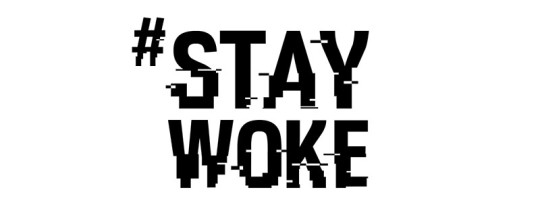
“Woke” is a buzzword that simultaneously makes me laugh and angrily shout obscenities. As I understand it, being “woke” is supposed to be refer to having awareness and a thorough knowledge of things like structural racism, misogyny, homophobia, politics, etc. But being “woke” has long devolved into a masturbatory status one betroths onto themselves as a jab towards anybody who doesn’t think the same way they do. And it’s marketed to consumers as just that instead of as encouragement to keep elevating the mind. At this point, do people take this term seriously anymore? I can’t look at this term as anything as a soulless piece of co-opted black vernacular.
Speaking of co-opting black culture, most of these well-connected people and publications who dictate the majority of the discourse around intersectionality still view whiteness as the standard. They talk a lot about white supremacy, white privilege, and concepts like that, but they mostly view people of color as trophies to adorn themselves with so that they look open-minded. For example, the uncritical adulation that these types of publications heap on Beyonce as a pro-black and feminist icon or their flippant use of the term “white feminist” as a derisive always stuck me as much more patronizing than a thoughtful or analytical view of Beyonce’s status as a pop star or racism within feminism. It was always more of a “look how much better and more enlightened than I am than those other white people! Aren’t I so down?” These publications aren’t 100% white or anything, but they’re almost always either owned or funded by white people. They’ll have no problem hiring a writer of color that tows their line and reinforces their outlook. This definitely plays into why they co-opt black vernacular buzzwords like “woke” or “bae” again and again. The irony is that these publications probably wrote a thinkpiece on how Kylie Jenner appropriated black culture when she donned cornrows.
This doesn’t just apply to co-opting pro-black politics. A few years ago, I came across this quiz from BuzzFeed on whether or not you are a feminist. It starts off by asking “do you believe in the complete equality of men and women”. If you answer yes, the quiz ends, stating “Yes, you are a feminist. Congrats!”. This result amused me and made me feel pretty good back then, but oversimplifications like this are part of the problem I’m addressing. This simple quiz tells you nothing about feminist theory, the history of feminism, how structural patriarchy has shaped our society, the different ways that patriarchy manifests, or anything like that.
I have to repeat that in the marketing of intersectionality or social justice, turning a profit is more important than actually being intersectional. It doesn’t matter to BuzzFeed that their little quiz oversimplified feminism as long as their articles and quizzes get clicks, which makes them money. It doesn’t matter to all those so-called “sex-positive” websites that their professed feminism is the same exact ideology of a man who for more than sixty years built an empire on the backs of millions of women he reduced to objects for his male audience because those sites found their own way of turning a profit from a pornographic view of sex. Hillary Clinton’s history of domestic and foreign policies that further marginalized the already marginalized groups of people didn’t matter as much as her elevation to the White House. The same exact thing about her can be said about former president Barack Obama and the Democratic Party’s latest up-and-coming cult of personality, Senator Cory Booker. It doesn’t matter to the Democratic Party that so much of their base’s prospect of upward mobility continues to diminish as long that they can pose as glorious saviors against those nasty Republicans. And most of those major publications I’ve been referring to are funded by the same corporations that funds all of the aforementioned Democratic politicians.
I’m still questioning what direction I want this blog to go in. I have written a great deal about intersectional and social justice concepts in the past and I worry that some of my earlier posts may have contributed to the marketing of them instead of actually standing for them. I don’t want to do that anymore. These concepts and particularly the groups of people they seek to give a voice to are far too important to let be reduced to cynical fad marketing ploys and I hope this blog can provide analysis on cartoons that does not do the same kind of disservice to them I’m witnessing in far too many other outlets.
0 notes